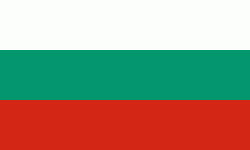Samokov
Samokov (Самоков ) is a town in Sofia Province in the southwest of Bulgaria. It is situated in a basin between the mountains Rila and Vitosha, 55 kilometres from the capital Sofia. Due to the suitable winter sports conditions, Samokov, together with the nearby resort Borovets, is a major tourist centre.
In the past, Samokov was a centre of handicrafts and art, with notable figures like Zahari Zograf, Hristo Dimitrov and Nikola Obrazopisov. The town's name is a compound word of "samo" and "kov", respectively meaning "self" and the root of the verb "forge, hammer", and comes from the samokov, a mechanical forge powered by water, since the town of Samokov was a major iron-producing centre during the Middle Ages.
It is thought that Samokov was founded in the 14th century as a mining settlement with the assistance of Saxon miners. It was first mentioned in 1455 and in Ottoman registers of 1477 as Vlaychov Samokov. Some of the best craftsmen, woodcarving masters and builders came from Samokov and were recognized for their skills in creating detailed and impressive woodcarvings, painting beautiful icons and building unique architecture.
In fact Samokov was one of the then famous three woodcarving schools in the region, the other two being Debar and Bansko. Their work can be seen in many churches and cultural buildings throughout the Balkan Peninsula. Between the 14th and 18th centuries, Samokov was established as an administrative center for iron ore mining by the ruling Ottoman Empire. From the 16th century until the abolishment of the Serbian patriarchate in 1766, Samokov was the seat of the easternmost eparchy of the Serbian Orthodox Church.
In the 16th and 17th centuries, it grew into the greatest iron extraction centre in the region, with western travellers describing it as 'a fairly large city'. In 1565–1566, Samokov had to produce and deliver to Belgrade 20,000 horseshoes and 30,000 nails. Samokov also produced anchors and other materials for the shipyards of the Bulgarian Black Sea Coast, particularly Pomorie. As the logging industry was also well developed, in 1573 the people of Samokov had to deliver 300 beams as far as Mecca.
As of today, some Aromanians live in Samokov.
In the past, Samokov was a centre of handicrafts and art, with notable figures like Zahari Zograf, Hristo Dimitrov and Nikola Obrazopisov. The town's name is a compound word of "samo" and "kov", respectively meaning "self" and the root of the verb "forge, hammer", and comes from the samokov, a mechanical forge powered by water, since the town of Samokov was a major iron-producing centre during the Middle Ages.
It is thought that Samokov was founded in the 14th century as a mining settlement with the assistance of Saxon miners. It was first mentioned in 1455 and in Ottoman registers of 1477 as Vlaychov Samokov. Some of the best craftsmen, woodcarving masters and builders came from Samokov and were recognized for their skills in creating detailed and impressive woodcarvings, painting beautiful icons and building unique architecture.
In fact Samokov was one of the then famous three woodcarving schools in the region, the other two being Debar and Bansko. Their work can be seen in many churches and cultural buildings throughout the Balkan Peninsula. Between the 14th and 18th centuries, Samokov was established as an administrative center for iron ore mining by the ruling Ottoman Empire. From the 16th century until the abolishment of the Serbian patriarchate in 1766, Samokov was the seat of the easternmost eparchy of the Serbian Orthodox Church.
In the 16th and 17th centuries, it grew into the greatest iron extraction centre in the region, with western travellers describing it as 'a fairly large city'. In 1565–1566, Samokov had to produce and deliver to Belgrade 20,000 horseshoes and 30,000 nails. Samokov also produced anchors and other materials for the shipyards of the Bulgarian Black Sea Coast, particularly Pomorie. As the logging industry was also well developed, in 1573 the people of Samokov had to deliver 300 beams as far as Mecca.
As of today, some Aromanians live in Samokov.
Map - Samokov
Map
Country - Bulgaria
 |
 |
| Flag of Bulgaria | |
One of the earliest societies in the lands of modern-day Bulgaria was the Neolithic Karanovo culture, which dates back to 6,500 BC. In the 6th to 3rd century BC the region was a battleground for ancient Thracians, Persians, Celts and Macedonians; stability came when the Roman Empire conquered the region in AD 45. After the Roman state splintered, tribal invasions in the region resumed. Around the 6th century, these territories were settled by the early Slavs. The Bulgars, led by Asparuh, attacked from the lands of Old Great Bulgaria and permanently invaded the Balkans in the late 7th century. They established the First Bulgarian Empire, victoriously recognised by treaty in 681 AD by the Eastern Roman Empire. It dominated most of the Balkans and significantly influenced Slavic cultures by developing the Cyrillic script. The First Bulgarian Empire lasted until the early 11th century, when Byzantine emperor Basil II conquered and dismantled it. A successful Bulgarian revolt in 1185 established a Second Bulgarian Empire, which reached its apex under Ivan Asen II (1218–1241). After numerous exhausting wars and feudal strife, the empire disintegrated and in 1396 fell under Ottoman rule for nearly five centuries.
Currency / Language
| ISO | Currency | Symbol | Significant figures |
|---|---|---|---|
| BGN | Bulgarian lev | лв | 2 |
| ISO | Language |
|---|---|
| BG | Bulgarian language |
| TR | Turkish language |















